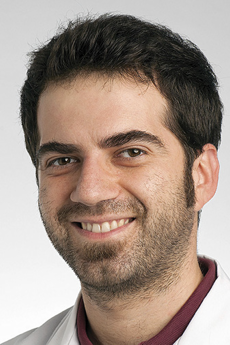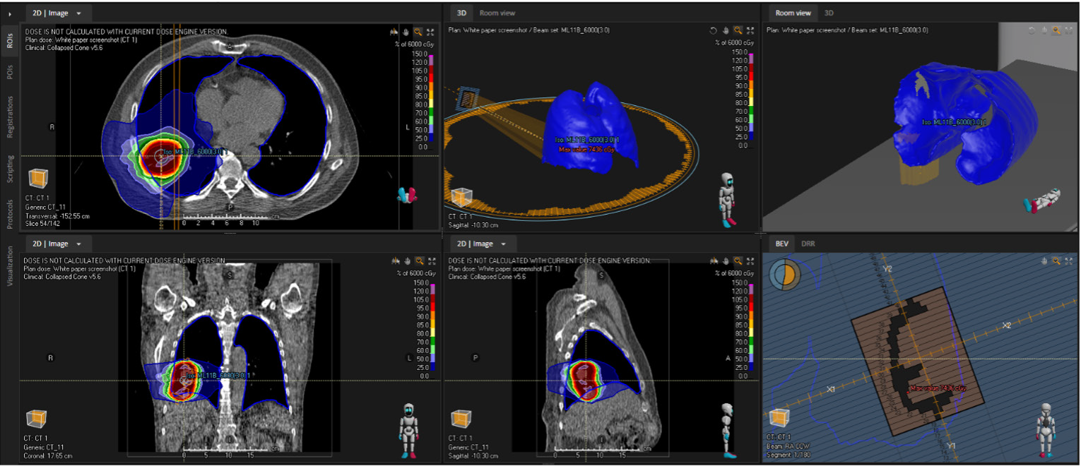Through the strategic integration of deep learning into the auto-planning process, the system now boasts enhanced reliability and flexibility, all while significantly expediting the workflow, ultimately saving valuable time.”

DEEP LEARNING PLANNING
The rapid advancements in deep learning technology have paved the way for automatic creation of clinical treatment plans. The RayStation®* deep learning planning module brings these cutting-edge technologies directly into the clinical workflow, offering a substantial boost in efficiency and consistency in patient care.
DEEP LEARNING PLANNING
Deep learning planning enhances the planning workflow by automating the creation of personalized treatment plans, significantly reducing the time required compared to manual treatment planning. This technology leads to more consistent and reproducible planning results, promoting a more standardized approach to patient care.
During inference, the network takes a multi-channel image volume as input and outputs a dose image volume with a voxel level dose prediction. The predicted dose is stored in RayStation and can be used as a reference dose for the mimic optimization.
Deep learning planning aids clinical personnel in exploring achievable treatment strategies, offering a new perspective on patient care. Deep learning plans can also be used as a foundation for further refinement, enabling clinical specialists to iteratively develop and improve treatment approaches
RAYSTATION INTEGRATION
RayStation® equips users with pre-configured models developed by RaySearch Laboratories, for different treatment areas and techniques. The interface, as depicted in Figure 1, allows users to choose from various dose prediction models for fast generation of plans.
RayStation® seamlessly incorporates deep learning technology into its planning process. This integration allows for the visualization of deep learning-generated dose distributions within the plan evaluation section, treating them as equivalent to traditional dose distributions in RayStation®.
Deep learning doses serve as a basis for mimicking optimization, facilitating the rapid creation of executable plans. Plans can be further refined and adjusted as with any conventional plan in RayStation. Deep learning planning is fully scriptable, which allows for automated pre-planning via batch processing of patients during off-hours. An example of the output produced by the model is illustrated in Figure 2.
Designed to comply with data privacy standards, our pre-trained models do not incorporate any patient images and operate entirely on-site, ensuring that patient information remains confidential and secure within the facility.



METHOD INFORMATION
RayStation® deep learning models for planning are designed to predict dose distributions that align with established clinical protocols and best practices for radiotherapy. The models are trained in a supervised manner to learn how to predict a dose value for each voxel.
The training is performed in an iterative process using a collection of patients where the input is a multichannel image volume, and the ground truth is an image volume that contains a dose distribution approved by a clinical specialist. The different channels of the multichannel input volume commonly contain unions of binary masks, extracted from RayStation RT structures, representing patient ROIs. No patient meta-data (such as weight, height, age, etc.) or patient images are used as input during training or inference.
Binary masks allow the model to learn where the radiation dose needs to be maximized (target volumes) or minimized (the surrounding organs or tissues) and how to compromise in the overlapping regions.
During the inference stage, the network accepts binary masks of RT-structures volumes as input and outputs a predicted dose.
Our deep learning planning architecture has been developed based on the U-net [1,2], , which consists of a contracting encoder part to analyze all the input channels and a successive expanding decoder part to produce a 3-dimensional dose distribution.
The models’ inputs are 3D binary masks, where every input channel is associated with the relevant ROIs for the given model site and protocol.
RayStation deep learning planning models provide a 3-dimensional voxel level dose distribution as output, which represents the prediction of radiation dose, targeting specific regions of interest including planning target volumes and organs at risk. The 3D dose prediction can be used as an input for the treatment plan optimization
REFERENCES
[1] Ronneberger, Olaf, Philipp Fischer, and Thomas Brox. "U-net: Convolutional networks for biomedical image segmentation." MICCAI 2015.
[2] Çiçek, Özgün, et al. "3D U-Net: learning dense volumetric segmentation
from sparse annotation." MICCAI 2016.
*Subject to regulatory clearance in some markets
For more information or to see a demo, contact sales@raysearchlabs.com